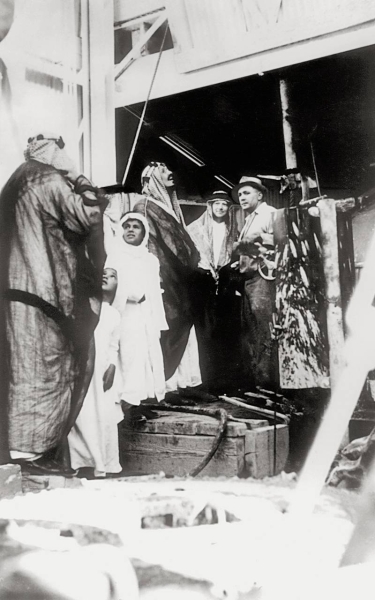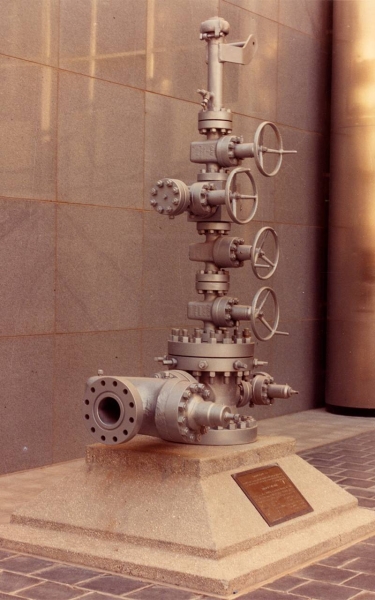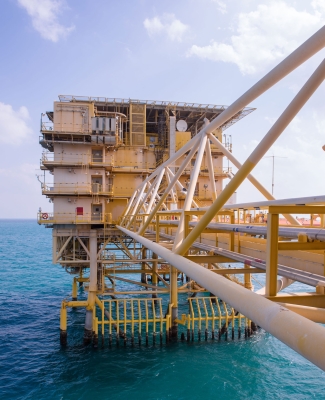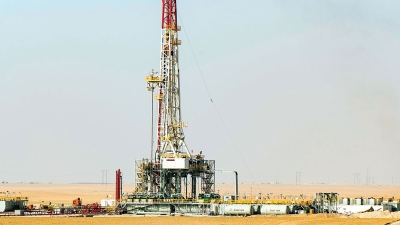


Dammam No. 7, or al-Khair Well, is the first well where commercial quantities of oil were successfully pumped. This marked the dawn of the oil era in the Kingdom of Saudi Arabia. On March 4, 1938, oil flowed from al-Khair test Well, drilled in the hill known as Jabal Dhahran at a depth of approximately 1,440 m within the Arabian porous limestone region.
The story of Dammam No. Seven
The story of Well No. Seven commenced with the arrival of the first geologists on September 23, 1933. They began a geological examination of the hills of Jabal Dhahran. Despite continuous examination, exploration, and excavation over the following two years, success eluded them.
On April 30, 1935, it was decided to commence work on digging Dammam Well No. One, using a cable-tool rig. After seven months of fluctuation between hope and despair, the well produced a strong burst of gas and some signs of oil when the drilling depth reached approximately seven hundred m. However, an equipment malfunction forced the drilling crew to stop the flow of the well and then seal it with cement. Dammam Well No. Two was in better condition, and work on digging it began at the time Dammam Well No. 1 was closed, specifically on February 8, 1936.
On May 11, 1936, the drilling team reached a depth of 633 m, which is the depth of the layer from which oil appeared in the Bahrain geological region. When the well was tested in June 1936, oil flowed from it at a rate of 335 barrels per day. A week later, after treatment with acid, the production of gushing oil from the well surged to 3,840 barrels per day. This encouraged the drilling of Dammam Wells No. Three, Four, Five, and Six, without waiting to verify if production would be in commercial quantities or to ascertain the size of the discovered field. Then, a decision was issued in July to prepare Dammam Well No. Seven for a deep test well.
Dammam Well brings hope
With high hopes for production by 1936, the number of Saudi workers rose to 1,076, in addition to 62 non-Saudi workers. Things were supposed to proceed normally, but at that time something unexpected happened. Dammam Well No. One, drilled to below 975 m, proved a failure. As for Dammam Well No. Two, it turned out to be 'wet', meaning it mainly produced water. In fact, its water production was eight or nine times greater than its oil production.
The production of Dammam Well No. Three did not exceed one hundred barrels of heavy oil per day, with 15 percent water. As for Dammam Wells No. Four and Five, it became apparent that they were dry, meaning they were unable to produce any fluids, and the same was true for Well No. Six.
Drilling Dammam No. Seven
Drilling operations persisted unabated, and on December 7, 1936, specialists commenced drilling deep test Well No. Seven, which initially did not augur well. Then, on October 16, 1937, at a depth of 1,097 m, the drillers encountered the first positive development: 5.7 l of oil in the diluted drilling mud from the well, accompanied by some gas.
Then, on the final day of 1937, the control equipment failed to contain the well and the well blew out, discharging all its liquids and gases. Despite reaching a depth of 1,382 m, the drilling team failed to discover a significant quantity of oil.
After that, conditions began to change. In the first week of March 1938, Dammam No. Seven achieved the hoped-for breakthrough at a depth of 1,440 m, just sixty m before the depth where geologists anticipated finding oil. It produced 1,585 barrels per day on March 4, 1938. This figure rose to 3,690 barrels on March 7. Approximately nine days later, the well's production reached 2,130 barrels, followed by 3,732 barrels after another five days, and finally 3,810 barrels the next day. At that time, the Dammam Wells No. Two and Four had been deepened to the level of the Arab geological zone and yielded favorable outcomes.
The Founding King Abdulaziz Bin Abdulrahman Al Saud expressed keen interest in providing all possible assistance to the company. As soon as the discovery of oil in commercial quantities was officially announced, which occurred after October 1938, preparations commenced for his visit to the Eastern Province.
In 1939, King Abdulaziz and his accompanying delegation moved from Riyadh towards the east, until they reached the company camp, officially called 'ad-Dhahran'. The timing of his visit coincided with the completion of the pipeline extending from the Dammam Field to the port of Ras Tannurah, spanning a length of sixty-nine km. The oil tanker 'D.G. Scofield' docked and King Abdulaziz turned the valve with his hand to fill it with the first shipment of Saudi oil. And so, this was the first shipment of crude oil exported by the Kingdom aboard a tanker on May 1, 1939.
Al-Khair Well stopped producing
After forty-five years of continuous production, during which it yielded 32,436,877 barrels of oil, this well was closed in 1982 due to operational reasons and subsequently excluded from the list of producing wells. Regarding Well No. Seven in Dammam, which significantly contributed to the country's prosperity, King Abdullah Bin Abdulaziz Al Saud ordered its renaming during his final visit to the site in 2008. Henceforth, it has been named 'al-Khair Well,' symbolizing its role in bringing goodness.
Related quizzes

